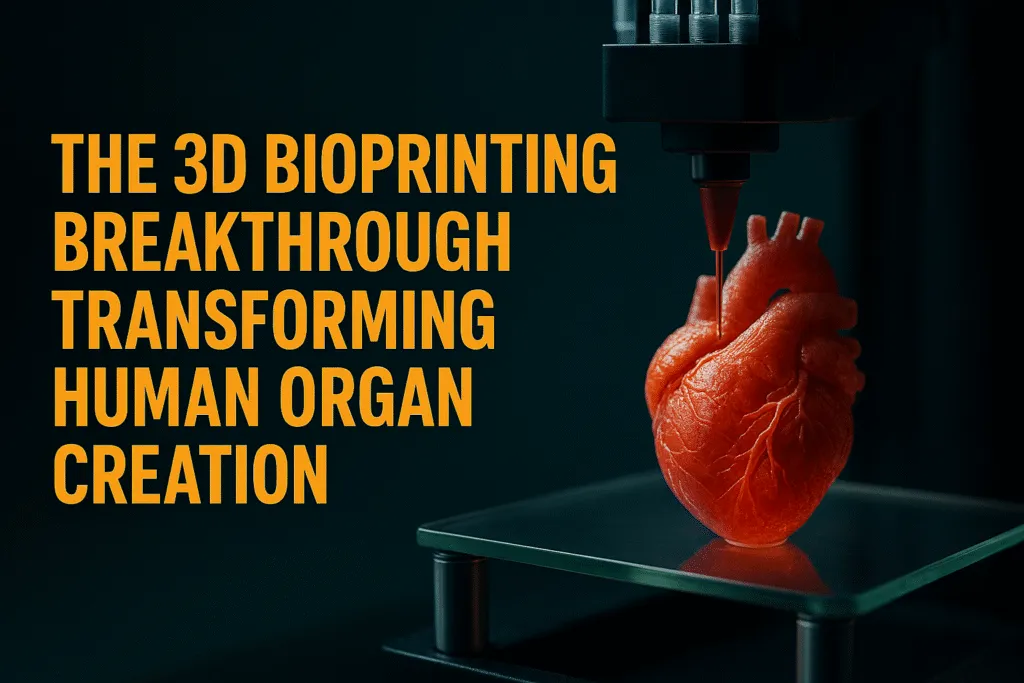Introduction – What is 3D Bioprinting?
The concept of 3d bioprinting is revolutionizing the world of medical science and reshaping the way we look at organ transplantation. At its core, 3d bioprinting is an advanced manufacturing process where scientists use specialized printers to create complex biological structures, layer by layer, using living cells and biomaterials. Unlike traditional 3D printing, which uses plastic or metal, this innovative method deploys bioinks made from stem cells that can develop into tissues and organs. The process begins by taking a detailed digital model of the required organ or tissue. This is done using powerful imaging technologies like MRI or CT scans. This virtual model is then translated into precise printing instructions, guiding the bioprinter to place each layer of cells accurately according to the design.
In simple terms, imagine building a human organ the same way an architect constructs a building on a computer and then brings it to life through a printer. 3d bioprinting offers the same possibility in healthcare. It allows researchers to build tissues such as skin, cartilage, and even parts of the heart, all inside a lab environment. The goal is not just to duplicate the shape of an organ, but to replicate its full biological function.
This technology is still in its early stage, but rapid progress is being made every year. The main advantage of 3d bioprinting is that it could reduce the need for donor organs and minimize the risk of rejection since the printed organs can be made using a patient’s own cells. As research continues, many experts believe we are getting closer to a future where lifesaving organs can be printed on demand inside specialized medical labs.
How 3D Bioprinting Technology Works
To understand how 3d bioprinting technology works, it helps to think of it as a highly sophisticated version of a normal 3D printer, but designed specifically to work with living cells. The process begins with the creation of a digital blueprint of the tissue or organ that needs to be printed. Using imaging tools like MRI and CT scans, scientists collect highly detailed data that maps the exact structure and shape of the biological part. This data is then converted into a design file that guides the bioprinter during the printing phase.
Once the design is ready, the next step involves preparing the bioink. Bioinks are special mixtures made up of living cells and supportive biomaterials. These cells can come from the patient’s own body or from stem cell cultures in the lab. The bioink is loaded into cartridges in the 3d bioprinter and is extruded layer by layer according to the digital design. As each layer is deposited, it begins to merge and form the complex structure of the target tissue.
During printing, the environment inside the bioprinter is carefully controlled to maintain ideal temperature, pressure, and nutrient supply. This ensures that the cells remain alive and functional. After the structure is printed, it is placed into a bioreactor, which provides the right conditions for the tissue to mature and develop biological functions. The growing tissue is regularly monitored and adjusted to support cell growth and organization.
Thanks to 3d bioprinting, scientists can now replicate natural tissues with remarkable precision. Although there is still a long way to go before full organs are commonly printed, this step-by-step process lays the foundation for a future where personalized, lab-grown organs may be routinely available for patients in need.
Key Components: Bioinks, Cells, and Printers
The success of 3d bioprinting relies heavily on three core components: bioinks, cells, and printers. Each of these elements plays a vital role in replicating the structure and function of real human tissues. Bioinks are the heart of the process. These are special formulations that contain living cells combined with natural or synthetic biomaterials. The biomaterials act like a scaffold, giving support and shape to the tissue as it is being printed. The embedded cells gradually grow and integrate within this structure, allowing the printed tissue to develop biological functionality over time.
The next essential component is the type of cells used in 3d bioprinting. Typically, researchers use stem cells, because they have the unique ability to transform into different types of specialized cells such as skin, muscle, or organ tissue. In many cases, doctors extract these stem cells from the patient’s own body to reduce the risk of rejection. These cells are cultured and multiplied in the lab before being mixed into the bioink.
Finally, there are the bioprinters themselves. Unlike standard 3D printers that use plastic, these advanced machines are designed to handle delicate living materials. They are equipped with precise nozzles and temperature‐controlled cartridges, allowing them to deposit the bioink layer by layer with extreme accuracy. Modern bioprinters can even print different cell types in specific locations to mimic the complex structure of real organs.
By combining high‐quality bioinks, patient‐specific cells, and highly accurate 3d bioprinting machines, scientists are getting closer to producing fully functional tissues and, eventually, full human organs. These three components work together like pieces of a puzzle, bringing the incredible potential of 3d bioprinting one step closer to reality.
Recent Breakthroughs in Organ Printing
In recent years, 3d bioprinting has moved from concept to reality with several remarkable breakthroughs in organ printing. One of the most exciting developments is the successful printing of small, functional tissues such as liver and kidney mini‐organoids. These lab‐grown structures can perform basic functions of real organs and are already being used for drug testing, reducing the need for animal experiments. Scientists have also managed to print heart tissue that can contract and pump fluid, demonstrating that 3d bioprinting can support complex biological activity.
Another major breakthrough came when researchers printed a full‐sized human heart using a patient’s own cells. Although it is not ready for transplantation yet, it proved that personalized organs can be designed and printed with accurate anatomical features. Similarly, a team of researchers successfully printed a human‐scale lung model, complete with the tiny airways that allow gas exchange. These achievements show how quickly 3d bioprinting is advancing toward its ultimate goal of functional organ replacement.
In addition to organs, scientists have started printing vascular networks, which are essential for transporting blood and nutrients throughout the printed tissues. Without proper blood flow, even the most advanced printed organs would not survive after transplantation. The successful creation of these vascular systems marks a critical step forward.
As 3d bioprinting technology continues to improve, more institutions around the world are launching clinical trials to test bioprinted tissues in real patients. While full organ transplantation using 3d bioprinting is still a few years away, recent breakthroughs clearly show that the technology is moving in the right direction. With each new milestone, the dream of printing fully functional human organs becomes more realistic and achievable.
Current Applications in Healthcare
Although fully printed organs are still under development, 3d bioprinting is already transforming healthcare with several real-world applications. One of the most common uses is the printing of customized tissues for research and pharmaceutical testing. Instead of relying on animal models, scientists can now use bioprinted human tissue to test new drugs and study disease behavior in a more accurate and ethical way. This speeds up the development of treatments and reduces the risks involved during clinical trials.
Another important application of 3d bioprinting is in regenerative medicine. Hospitals and research labs are using printed skin grafts to treat burn victims and patients with severe wounds. These bioprinted skin tissues are made using the patient’s own cells, which helps improve healing and reduces the chances of rejection. Similarly, cartilage tissues are being printed to repair damaged joints, offering an alternative to traditional implants.
Dental and orthopedic fields are also benefiting from 3d bioprinting. Customized bone structures are being bioprinted to fill defects caused by injury or disease. These printed bones are designed to perfectly match the patient’s anatomy and promote natural bone regeneration once implanted. Some researchers are even experimenting with printing blood vessels and heart patches to repair damaged heart tissue in patients suffering from cardiovascular diseases.
Beyond direct patient care, 3d bioprinting is used to create personalized surgical models. Surgeons can practice complex procedures on realistic models printed from a patient’s own scan data, helping improve accuracy and reduce complications during the actual surgery.
These current applications of 3d bioprinting are clear signs that the technology is already having a positive impact in healthcare. As the field continues to evolve, more advanced and lifesaving uses of 3d bioprinting are expected to become part of everyday medical practice.
Challenges and Ethical Concerns
While 3d bioprinting offers incredible potential, it also presents several significant challenges and ethical concerns that must be addressed as the technology evolves. One of the biggest technical challenges is ensuring long-term functionality and stability of printed tissues and organs. Even when a structure is successfully printed, it must be able to survive and function properly inside the human body. Creating complex vascular networks that can deliver nutrients and oxygen throughout the printed organ remains a major obstacle.
Another challenge is the high cost of 3d bioprinting equipment, bioinks, and research. Most of the work in this field is still limited to well-funded laboratories and research institutions. Until the cost comes down, it may be difficult to scale up and make 3d bioprinting accessible to hospitals and patients around the world.
Ethical concerns are also an important part of the discussion. One issue is the source of the cells used in the printing process. Some methods rely on embryonic stem cells, which raises moral questions for certain groups. Even when using adult stem cells, questions arise about ownership and consent. If a patient’s cells are used to create an organ, who has the rights to that organ, the patient or the institution that created it?
There are also broader concerns about the potential misuse of 3d bioprinting technology. For example, could this technology be used to create enhanced or modified human organs for non-medical purposes? The idea of printing organs on demand raises questions about regulation, accessibility, and the possibility of black-market activity.
Addressing these challenges and ethical concerns will require clear laws, strict oversight, and ongoing dialogue between scientists, ethicists, and policymakers. Only then can 3d bioprinting reach its full potential in a safe and responsible way.
Future Scope of 3D Bioprinting in Medicine
The future scope of 3d bioprinting in medicine is both vast and extremely promising. As the technology continues to advance, experts believe it will move well beyond experimental labs and play an active role in mainstream healthcare. One of the most anticipated developments is the creation of fully functional organs that can be transplanted into patients. Instead of waiting on long donor lists, patients could receive custom-made organs printed from their own cells, reducing both wait time and the risk of rejection.
Another exciting possibility is the use of 3d bioprinting for personalized drug treatment. Doctors could print small tissue samples specific to an individual patient and use them to test how well different drugs work before prescribing them. This would allow for highly precise and effective treatment plans tailored to each person’s biological makeup.
In the future, 3d bioprinting could also play a key role in emergency medicine. Portable bioprinters might be used in hospitals or disaster zones to quickly print tissue patches for wounds, burns, and internal injuries. This type of on-demand treatment could dramatically improve survival rates and recovery times.
Researchers are also exploring the long-term use of bioprinted tissue for organ repair rather than full replacement. Instead of replacing an entire organ, doctors may one day replace only the damaged portion, helping preserve more of the patient’s natural tissue.
As new materials, smarter bioinks, and more precise printers are developed, the potential applications of 3d bioprinting will expand even further. With proper regulation and continued innovation, 3d bioprinting has the potential to transform modern medicine, making personalized healthcare more efficient, accessible, and effective than ever before.
Conclusion – When Will Lab‐Printed Organs Become Reality?
The journey of 3d bioprinting from early experimentation to real-world medical application has been nothing short of remarkable. Although scientists have made impressive progress in printing functional tissues, the dream of fully transplantable lab-printed organs is still in development. Current research shows that simple structures like skin, cartilage, and miniature organoids can already be produced and used effectively in specific treatments and drug testing. However, printing complex organs such as hearts, lungs, and kidneys requires advanced vascular systems that can support long-term survival and function inside the human body.
Experts believe that we may see the first successful 3d bioprinted organ transplants within the next decade, especially as printers become more precise and bioinks become more sophisticated. Several clinical trials are already underway, and the results so far are very encouraging. Once the technology reaches a point where printed organs can mimic real biological behavior consistently, regulatory approval will follow. This will likely start with small-scale, life-saving trials for patients who have no other options.
Even after 3d bioprinting becomes a clinical reality, widespread availability may take a few more years due to cost, production capacity, and ethical reviews. In the long run, however, this technology has the potential to eliminate organ shortages entirely and offer customized solutions for patients around the world. While we are not there yet, every breakthrough brings us closer to a future where lab-printed organs are not just possible but routinely used in hospitals. The next few years will be critical in turning the potential of 3d bioprinting into a lifesaving reality.
Also Read: Cloudburst Uncovered 2025: Nature’s Most Violent Rainfall Explained.
FAQs
Q1. What is 3d bioprinting in simple terms?
3d bioprinting is a technology that uses special printers and living cells to create human tissues and organs layer by layer in a lab environment.
Q2. Are 3d bioprinted organs available for transplant today?
Not yet. Researchers have successfully printed small tissues, but fully functional organs for human transplant are still in the development and testing phase.
Q3. What materials are used in 3d bioprinting?
The main materials include bioinks made of living cells, hydrogels, and supportive biomaterials that help form the structure of the printed tissue.
Q4. Why is 3d bioprinting important for healthcare?
It can reduce reliance on donor organs, lower the risk of rejection, speed up drug testing, and provide personalized medical solutions.
Q5. How long does it take to print an organ?
Printing time varies depending on the complexity of the organ. Simple tissues may be printed in a few hours, while complex organs could take days or even weeks.
Q6. What are the major challenges in 3d bioprinting?
Creating stable vascular systems, ensuring long-term functionality, and reducing costs are some of the biggest technical and financial challenges.
Q7. Is 3d bioprinting safe?
Early lab tests show promising results, but full safety for human use will only be confirmed after extensive clinical trials and regulatory approval.
Q8. When will lab-printed organs become a common option?
Experts estimate that the first successful clinical transplants could happen within the next 10 years, followed by gradual adoption in healthcare systems worldwide.





























